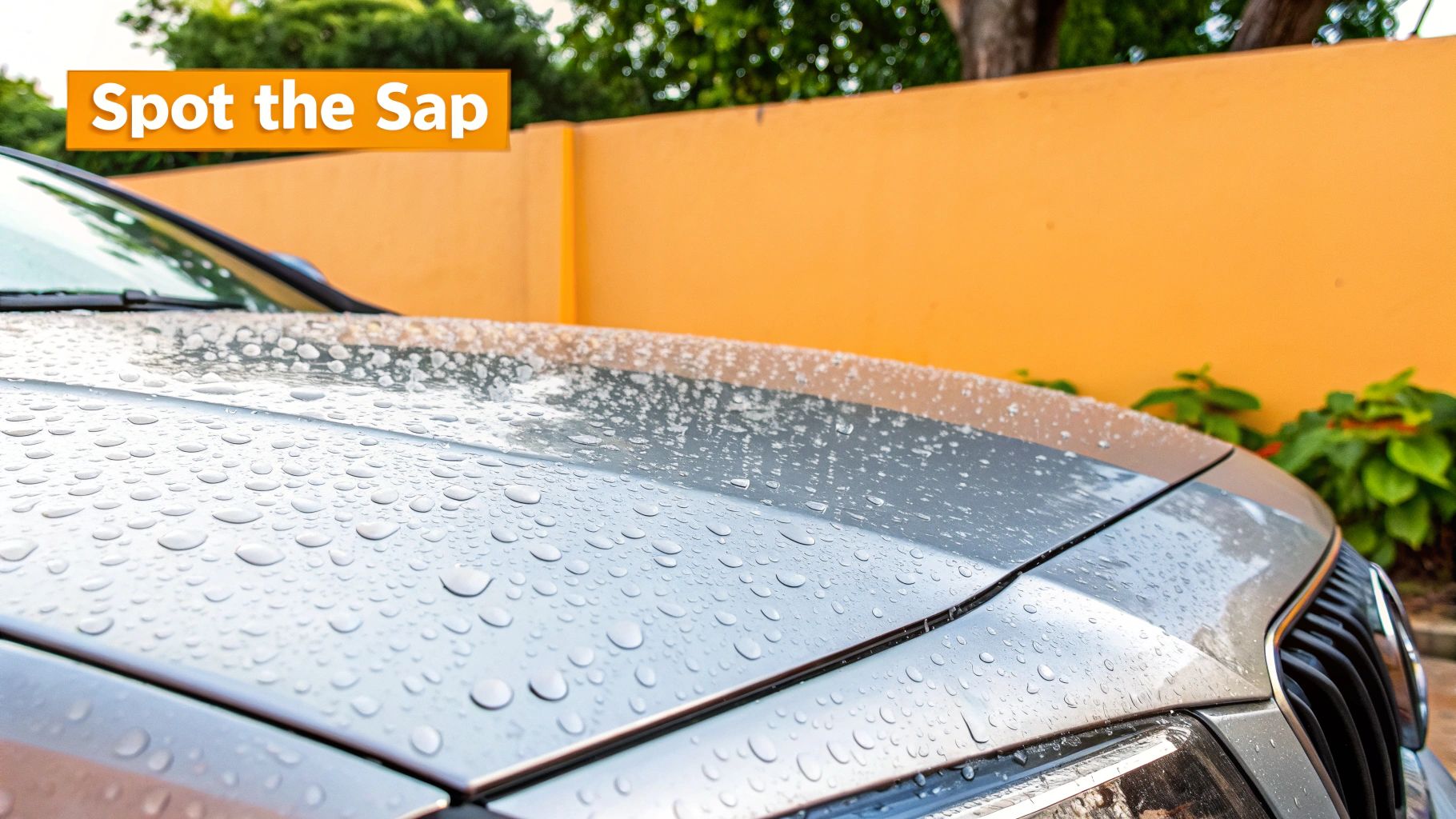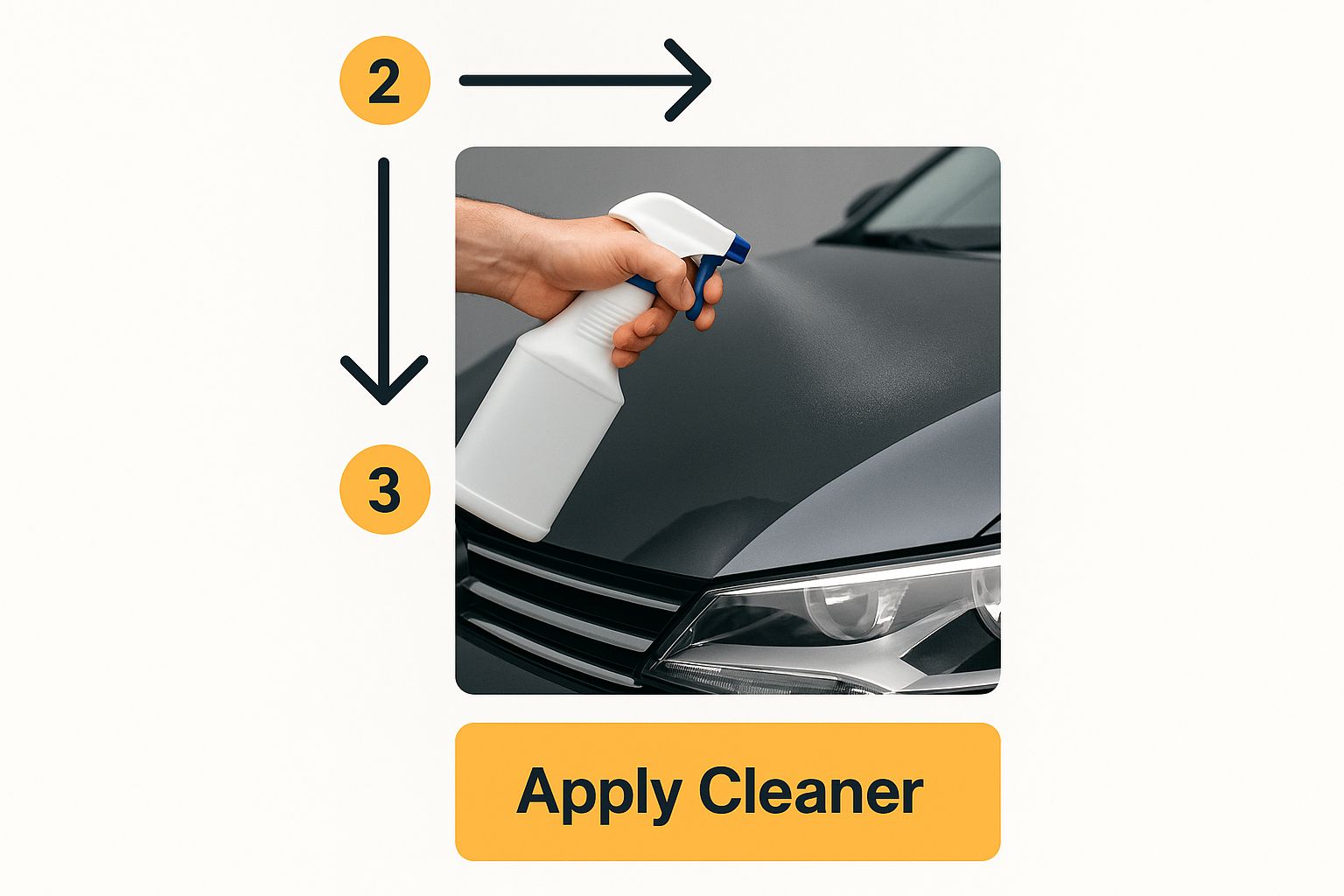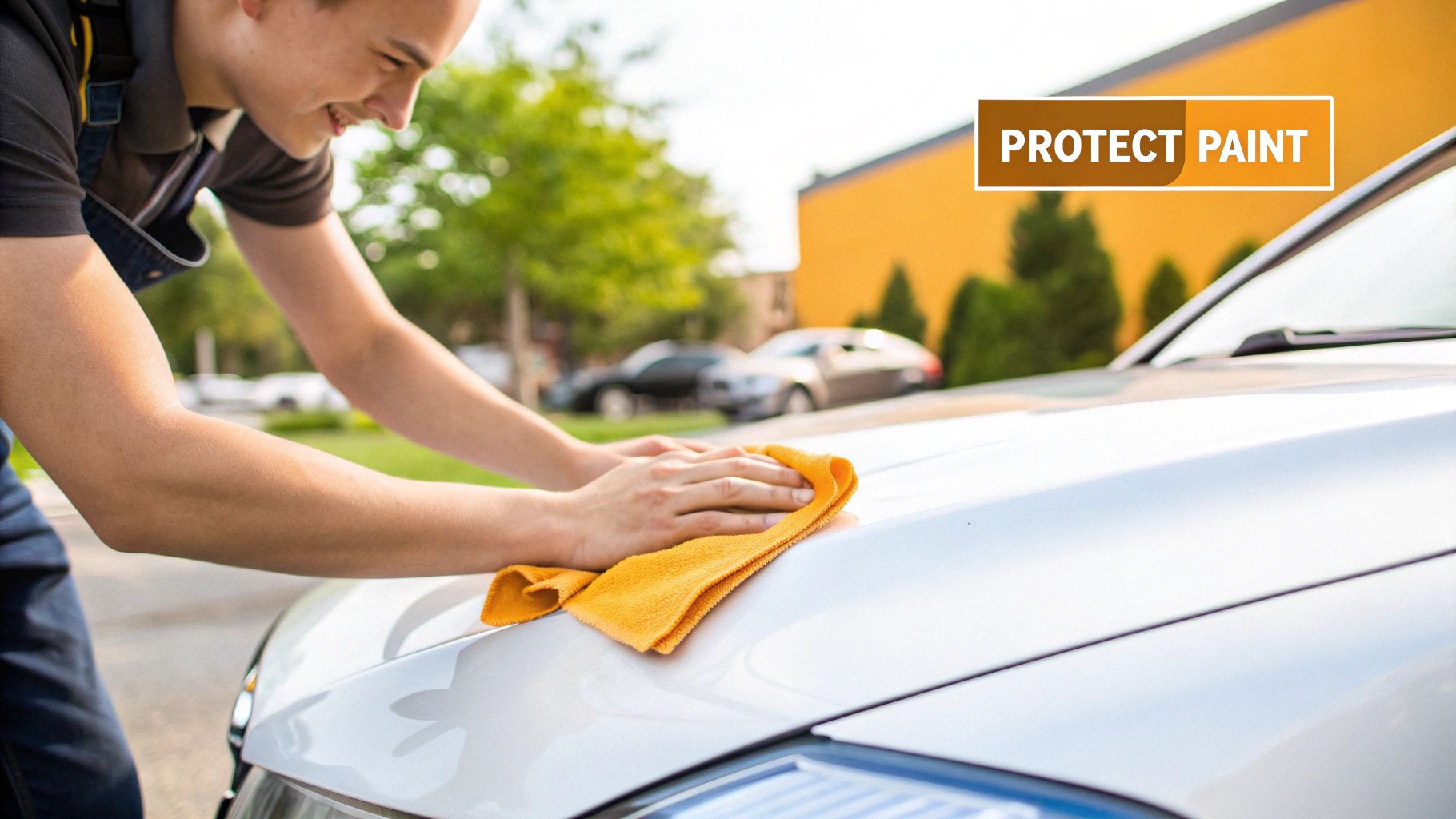Why Tree Sap Is Your Car's Silent Enemy

That glistening drop of tree sap on your car might seem harmless, but it's a significant threat to your car's finish. This sticky substance, a blend of sugars, resins, and other organic compounds, adheres strongly to automotive surfaces. It acts like nature's superglue, meant to protect trees. Unfortunately, this same bonding power makes it a formidable challenge to remove from your car's paint.
The Science Behind the Stick
Tree sap's stickiness comes from its unique chemical makeup. The resins act as a natural adhesive, while the sugars create a viscous texture that attracts dirt and pollutants. This combination spells trouble for your car's paint. As the sap dries and hardens, it becomes even more stubbornly adhered, embedding itself in the microscopic imperfections of your car's clear coat.
Environmental Factors: Accelerating the Damage
Sunlight and heat worsen the problem. Sunlight bakes the sap onto the paint, increasing removal difficulty. Heat softens the clear coat, allowing the sap to penetrate deeper, potentially causing paint etching, a permanent discoloration or dulling. Trapped dirt and pollutants act as abrasives, scratching the paint during removal attempts. Tree sap removal is a vital part of car maintenance. Consumer Reports emphasizes prompt removal and proper cleaning techniques to prevent long-term damage.
The Cost of Neglect
Ignoring tree sap can have substantial financial consequences. A damaged paint job diminishes your car's resale value, potentially by 10-15% depending on the damage. A small, sticky spot can escalate into a costly repair. Knowing when to get professional help is important. Preventative auto repair can also help mitigate these issues. Promptly addressing tree sap isn't just about aesthetics; it's about safeguarding your vehicle's value.
The Sap Removal Arsenal: Tools That Actually Work
Don't let tree sap ruin your car's finish. With the right tools and a bit of knowledge, you can effectively remove this sticky nuisance. Forget brute force; successful sap removal requires smart strategies and the right tools.
Commercial Sap Removers: Choosing the Right Product
The market is overflowing with sap removers, but not all are created equal. Dedicated sap removers designed for cars are your best bet. Look for products specifically formulated to dissolve sap without harming your car's paint or clear coat. Products like Stoner Car Care Tarminator and Koch-Chemie Eulex are known for their effectiveness. Choosing the right product is crucial for successful sap removal.
Parking under trees, a common practice for about 50% of car owners, significantly increases the risk of sap encounters. Considering that roughly 80% of sap removal attempts require specific products or techniques to prevent paint damage, choosing the right product is essential. Learn more about sap removal best practices.
To help you make an informed decision, we've compiled a comparison table highlighting some of the most popular options:
To help you choose the best sap remover for your needs, we've compiled a comparison of several popular commercial products. This table highlights key differences in effectiveness, paint safety, ease of use, and price.
Essential Tree Sap Removal Products Comparison: This table compares different commercial sap removal products based on effectiveness, safety for paint, ease of use, and price point.
| Product Name | Effectiveness | Paint Safety | Ease of Use | Price Range |
|---|---|---|---|---|
| Stoner Car Care Tarminator | Excellent | Excellent | Easy | Moderate |
| Koch-Chemie Eulex | Excellent | Excellent | Easy | Moderate |
| Turtle Wax Bug & Tar Remover | Good | Good | Easy | Budget-friendly |
| Meguiar's Gold Class Bug & Tar Remover | Good | Good | Easy | Moderate |
| Chemical Guys Bug & Tar Remover | Good | Good | Easy | Moderate |
As you can see, products like Stoner Car Care Tarminator and Koch-Chemie Eulex offer excellent effectiveness and paint safety, while others provide a more budget-friendly option with good performance.
Microfiber Towels: Protecting Your Car's Finish
Using the right tools is just as important as the sap remover itself. Microfiber towels are essential for effective and safe sap removal. Their fine fibers gently lift and trap the softened sap without scratching your car's finish. Avoid abrasive cloths or paper towels, which can cause swirl marks and scratches. Investing in high-quality microfiber towels helps preserve your paint's integrity.
Household Items: For Emergency Use Only
In a pinch, some household items can offer temporary relief. Isopropyl alcohol (rubbing alcohol), diluted with water, can help soften fresh sap. However, use this with caution and test it in an inconspicuous area first, as higher concentrations can damage some paints. Cooking oils can also soften hardened sap but require thorough cleaning afterward to prevent residue. While these offer temporary solutions, dedicated sap removers offer the best long-term protection for your car's finish.
From Sticky to Spotless: The Step-by-Step Process

This infographic illustrates the first step in removing tree sap from your car: applying a cleaning solution. Proper application is essential for lifting the sap effectively. This crucial first step preps the area for successful removal, softening the sap before any scrubbing occurs.
Initial Preparation: Setting the Stage for Success
Before starting, park your car in a shaded area. Direct sunlight can harden the sap, making removal much more difficult. This simple precaution can save significant time and effort. Once parked in the shade, rinse the affected area with warm water and a high-quality car wash soap like the SwiftJet solution. This pre-wash removes loose dirt and debris, preventing scratches during the sap removal process.
Treating Fresh Sap: A Gentle Approach
Fresh tree sap requires a gentle approach. The initial steps of identification and preparation are crucial to minimizing damage. Experts recommend moving the vehicle to a shaded area and pre-washing with warm water and car wash soap. Waterless wash products can also be used for quick spot cleaning. Next, apply a dedicated sap remover or isopropyl alcohol to a microfiber towel. Gently rub in circular motions to break down the residue. Learn more about tree sap removal. Soak a microfiber towel with the sap remover and hold it against the sap for the dwell time specified by the manufacturer. This allows the remover to penetrate and soften the sap. Gently wipe with the towel, using minimal pressure. Repeat the soaking and wiping process if the sap doesn't come off easily.
Tackling Hardened Sap: Patience and Persistence
Hardened sap demands more persistence. Begin by softening the sap with a dedicated sap remover or isopropyl alcohol (70% concentration is recommended). Apply the product to a microfiber towel and hold it against the hardened sap for several minutes, allowing it to penetrate and soften the deposit. Gradually work the sap loose using gentle, circular motions. Avoid excessive pressure to prevent scratching your car's finish. For particularly stubborn sap, repeat the process several times, ensuring adequate dwell time.
Final Touches and Protection: Preserving Your Car's Shine
After removing the sap, thoroughly rinse the area with clean water to remove any remaining residue. Follow up with a coat of wax or sealant to protect your car's finish and prevent future sap from adhering strongly. This protective layer shields against environmental contaminants and simplifies future cleaning. Regular washing and waxing helps maintain your car's shine and prevents long-term damage from tree sap and other environmental factors. Following these steps will keep your car looking its best. Remember, patience and the right products are key to combating tree sap.
Pantry to Paint Job: Household Solutions That Surprise
Commercial sap removers are undoubtedly effective. But what if you're in a sticky situation without any specialized products? Surprisingly, everyday items from your pantry and bathroom cabinets might hold the solution. This section explores the science behind using common household items to remove tree sap from your car.
Rubbing Alcohol: A Powerful Solvent
Isopropyl alcohol (rubbing alcohol) is a common household item that can effectively dissolve tree sap due to its solvent properties. However, the correct dilution is crucial. A 70% concentration of isopropyl alcohol is generally recommended for car paint.
Higher concentrations could strip waxes or even damage the clear coat. Think of it like cleaning a delicate fabric: you wouldn’t use bleach when a gentle detergent would do. Always test the solution on an inconspicuous area first.
For added safety, dilute the alcohol further with water. This minimizes the risk of paint damage while still effectively removing sap.
Cooking Oils: Softening Stubborn Sap
Certain cooking oils can soften hardened tree sap, making it easier to remove. Vegetable oil and canola oil are generally safe for car paint. They work by penetrating and loosening the hardened sap deposits.
Similar to soaking a stuck bolt in penetrating oil, these oils help break the bond between the sap and the car’s surface. Apply a small amount of oil to a microfiber towel and gently rub the affected area.
Remember to thoroughly wash the area with a quality car wash soap, such as SwiftJet, after using oil. This removes any oily residue, preventing dirt and dust buildup that can dull your car’s finish.
Hand Sanitizer: A Surprising Solution
In a pinch, hand sanitizer can also remove tree sap. Many hand sanitizers contain a high percentage of alcohol, making them surprisingly effective against fresh sap.
However, like rubbing alcohol, use hand sanitizer cautiously. Test it in a hidden area first, and dilute it with water if concerned about potential paint damage. While convenient in emergencies, hand sanitizer isn't a perfect substitute for dedicated sap removers or diluted isopropyl alcohol.
For optimal results and to protect your car’s finish, choose dedicated car care products whenever possible. After using any of these household solutions, protect your car’s paint with a coat of wax or sealant. This barrier helps prevent future sap from sticking and simplifies future cleaning.
Remember, these household remedies are for occasional, emergency use. For consistent, reliable tree sap removal, dedicated sap removers offer superior performance and paint safety.
Beyond Removal: Restoring Your Paint's Protective Barrier
Removing tree sap is the crucial first step, but it's only half the battle. Just like cleaning a wound is important, so too is protecting it with a bandage. Proper care after sap removal determines the long-term health and appearance of your car's paint, protecting it from future damage and preserving its shine.
After the sap is gone, residues from cleaning products can linger. These can compromise the effectiveness of waxes and sealants, preventing them from properly adhering to the paint. Think of trying to stick tape to a dusty surface – it just won't hold.
The Importance of Thorough Rinsing
Thorough rinsing is paramount. It removes all traces of cleaning products, creating a clean slate for your chosen protective product to bond effectively with the paint. This ensures the best possible protection and maximizes the lifespan of your wax, sealant, or coating.
Choosing the Right Protection: Waxes, Sealants, and Ceramic Coatings
Several options exist for restoring your paint's protective layer: waxes, sealants, and ceramic coatings. Each offers different levels of durability and protection, catering to various needs and budgets. Your choice depends on factors like your parking environment, how often you wash your car, and how much you’re willing to spend. You might be interested in: How to master car care.
To help you decide, here’s a table outlining the key differences between these protective options:
Paint Protection Options After Sap Removal
This table outlines different paint protection products to apply after sap removal, their durability, level of protection, and application difficulty.
| Protection Type | Durability (months) | Level of Protection | Ease of Application | Cost |
|---|---|---|---|---|
| Car Wax | 1-3 | Good | Easy | Low |
| Sealant | 3-6 | Very Good | Moderate | Moderate |
| Ceramic Coating | 12+ | Excellent | Difficult | High |
Car wax provides good protection against environmental contaminants and UV rays, but it typically only lasts a few months. Sealants offer enhanced durability and protection compared to waxes, lasting for several months. For the ultimate protection, ceramic coatings form a semi-permanent bond with the paint, lasting for years and offering exceptional resistance to sap, UV rays, and other contaminants.
Developing a Complete Protection Strategy
Protecting your car from tree sap requires a comprehensive strategy. This involves strategic parking, regular washing, and the application of a protective layer. These combined efforts create a strong defense against this sticky menace.
If you frequently park under trees, a car cover or canopy can be a worthwhile investment. Prompt removal of any sap that does land on your car is essential, followed by the application of a protective product. Regular washing with a high-quality car wash soap like SwiftJet is also vital. By being proactive and implementing these strategies, you can minimize the impact of tree sap and keep your car looking its best. Consistent maintenance is key to preserving your car's finish and value.
Strategic Parking: Outsmarting Sap Before It Strikes

The most effective way to handle tree sap on your car is to prevent it in the first place. This involves proactive parking, understanding why sap drips, and using protective measures when needed. Strategic parking can significantly reduce the time and effort you spend cleaning sap off your car.
Identifying High-Risk Trees
Different tree species produce different types of sap. Some trees are more likely to leave sticky residue on your car than others. Pine and fir trees, for example, are known for their sticky resin. Maple and fruit trees attract aphids, which produce a sticky substance called honeydew. Knowing how to identify these high-risk trees can help you avoid parking underneath them.
Understanding Seasonal Patterns and Weather Conditions
Several factors influence sap production, including temperature, humidity, and the time of year. Sap flow is typically highest during warm, dry weather. Spring and summer are generally peak seasons for sap, especially during extended periods of sunshine. Keeping these seasonal variations in mind can inform your parking choices. Rain can exacerbate the problem by washing sap and honeydew from trees onto your car.
Practical Parking Strategies
Simple parking strategies can make a big difference. Whenever possible, avoid parking directly under trees, particularly during peak sap season. If you have to park near trees, consider the wind direction. Sap and honeydew can be carried by the wind, so parking next to a tree can still result in sticky deposits. For general car maintenance and protection against potential sap damage, following established car maintenance tips can be beneficial. You can also find more helpful advice in this article on How to master car care.
Protective Measures: Shielding Your Car From Sap
Several protective measures can shield your car. Car covers provide a physical barrier, while canopies offer partial protection when parked outdoors. These might not be practical for daily use, but they are valuable during peak sap season or when parking in high-risk areas. If sap does get on your car, quick removal is essential. Keeping a SwiftJet car wash foam gun and microfiber towels in your car allows you to quickly address sap before it hardens. This proactive approach minimizes the risk of damage and simplifies cleaning. By adopting these preventative strategies, you can effectively outsmart sap and keep your car’s finish pristine.
When to Call the Pros: Signs DIY Isn't Enough
While many tree sap removal situations can be handled with do-it-yourself (DIY) methods, some instances require professional intervention. Knowing when to call in the experts can save you time, money, and potential damage to your car's finish. This section explores those critical moments when DIY just isn't enough.
Clear Coat Damage: Spotting the Subtle Signs
One clear sign you need a professional is suspected clear coat damage. If you notice dull spots, discoloration, or a rough texture where the sap was, it's possible the clear coat has been compromised. Professionals have the expertise and tools to assess the damage and recommend the appropriate course of action, whether it be polishing or, in more severe cases, repainting. This requires a trained eye and specialized tools, so it's best left to the experts.
Paint Etching: When Sap Becomes Permanent
If you see a faint, ghost-like outline of the sap even after removal, it's a sign of paint etching. This means the sap has permanently altered the paint's surface. Professionals can often minimize the appearance of etching through polishing or other corrective techniques. Trying to fix this yourself could worsen the damage.
Repeated DIY Attempts: Knowing When to Stop
Repeated DIY attempts can be more detrimental than helpful. If you've tried removing the sap multiple times without success, it’s time to call a professional. Further attempts could scratch the paint or further damage the clear coat. This is particularly true for hardened sap, which requires specialized techniques and products.
Choosing a Qualified Detailer: Questions to Ask
When selecting a professional detailer, look for experience and positive customer reviews. Ask about their specific methods for tree sap removal and the products they use. A reputable detailer will be transparent about their process and happy to answer your questions. Inquire about their experience with clear coat correction and paint etching. Don't hesitate to ask for references or before-and-after photos. By hiring qualified professionals, you can ensure your car receives the best possible care.
Protect your vehicle and simplify future washes with the SwiftJet Car Wash Foam Gun. Its thick, clinging foam effortlessly lifts away dirt, grime, and even stubborn tree sap, making car maintenance a breeze.






